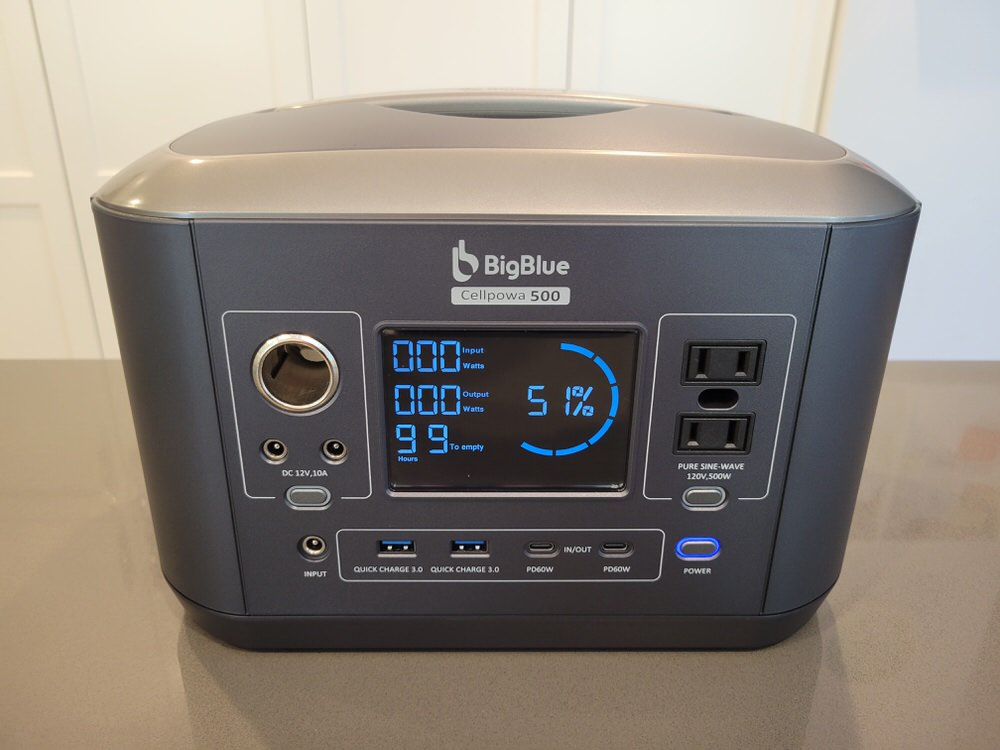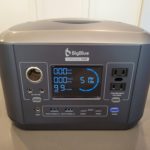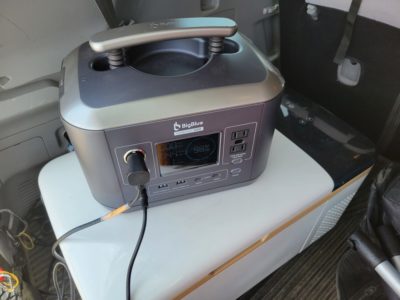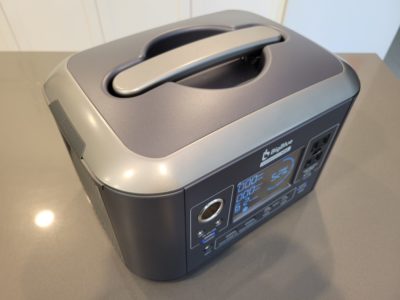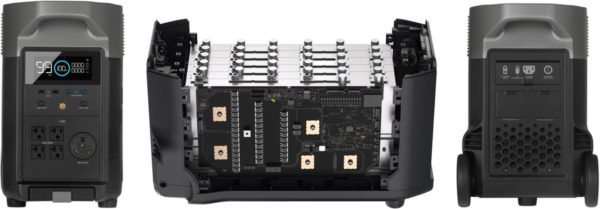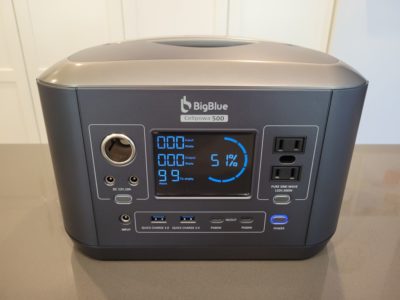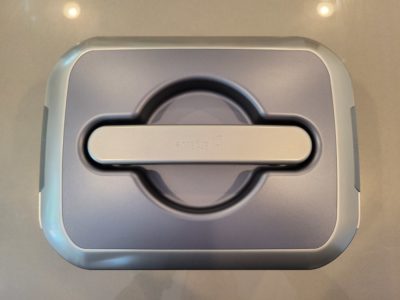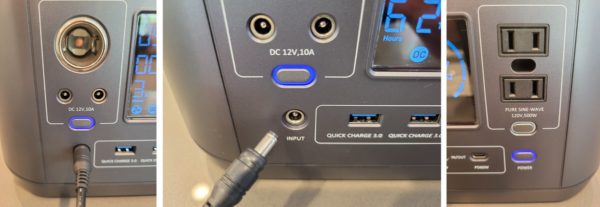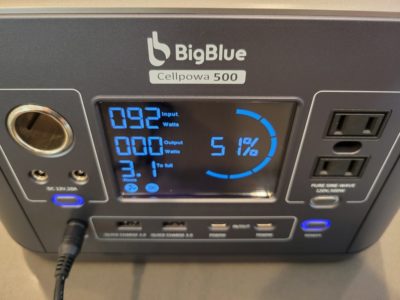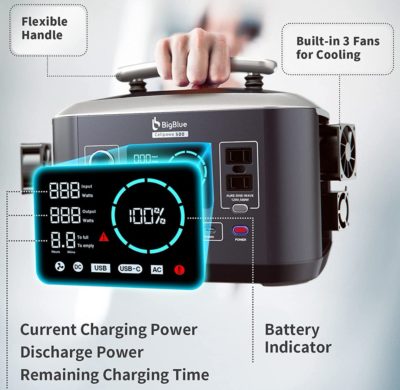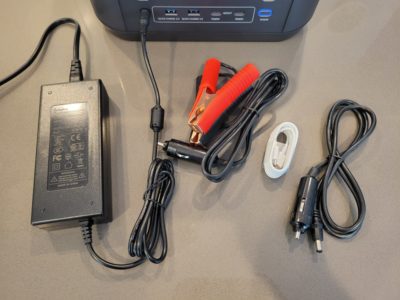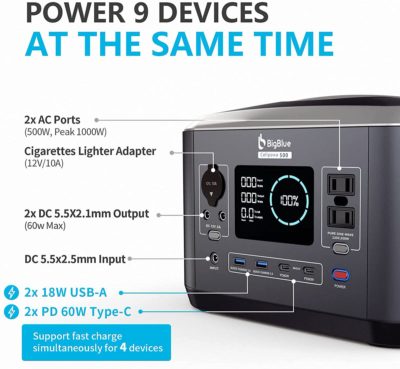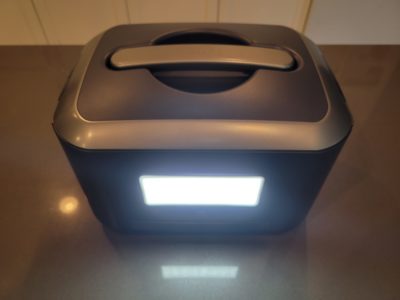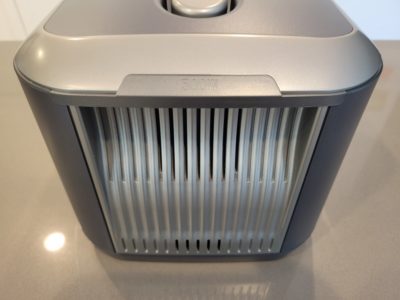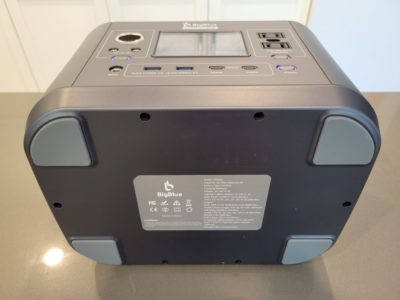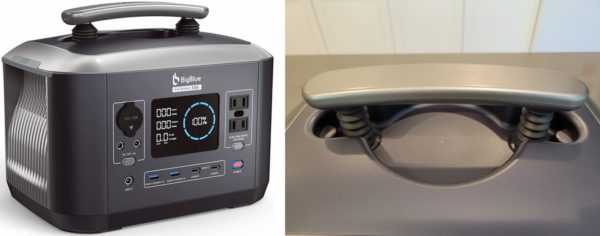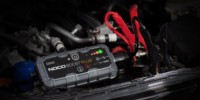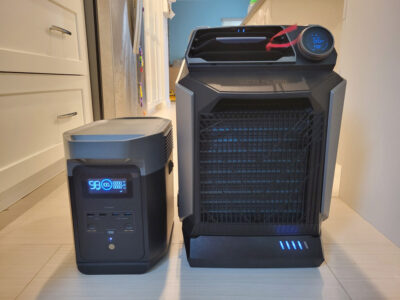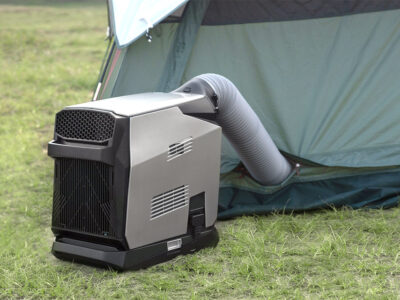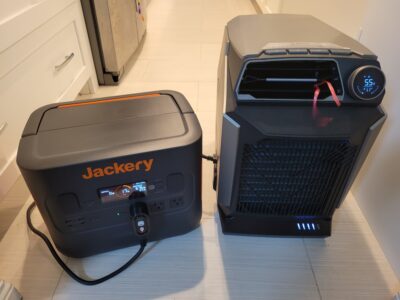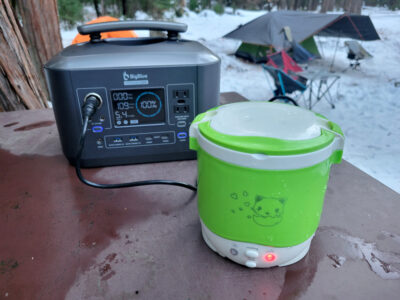BigBlue Cellpowa500
Contents
Li-ion: LiFePO4 or NMC?
You probably already know what a power station is for, but what you may not know about is whether the BigBlue CellPowa500 is better than Goal Zero, Jackery, Rockpals, Ecoflow, Bluetti, etc. As always, when it comes to “what’s best”, the answer will be: it depends. What all have in common, however, is that they are excellent for disasters and travel where power is needed. All have the capability to be recharged by a car’s 12V cigarette port, AC brick wall, and/or solar panels.
I use a small battery for grocery shopping. Groceries? Yes! Hear me out on that one. But before you write me off as some crackhead, I’d like to preface that I have extensive experience with Goal Zero, Jackery, Rockpals, and other branded Lithium-ion Nickel Manganese Cobalt (NMC) battery power stations that I use for extended camping trips and home emergencies.
What Will Be Covered Here
In this review, I will go over:
- Lithium-ion (Li-ion): Nickel Manganese Cobalt (NMC) vs Lithium Iron Phosphate (LiFePO4) battery cell differences
- Pros and Cons of this BigBlue battery
- Basics like Watts, Watt-hours, Continuous vs Peak rating, and more
There has been an increase in people taking emergency preparation more seriously amidst climate change, wildfires, hurricanes, flooding, and so on.
Battery Technology and Safety
Goal Zero debuted with Lead-Acid batteries that were bulky and heavy. Today’s devices use Lithium-ion — commonly Nickel Manganese Cobalt (NCM) or Lithium Iron Phosphate (LiFePO4 / LFP) chemistries — for more power in a smaller, lighter package. NMC, however, is more volatile than LiFePO4 and becomes riskier as more cells are packed together. Goal Zero and Jackery used NMC for some time whereas EcoFlow and Bluetti use LiFePO4. Jackery launched its first LiFePO4 model in mid-June 2023 and Goal Zero in October that year.
- How much energy a battery can store is measured in Wh (Watt-hours), and how much power is used or produced in W (Watts)
- The higher the Watt-hour (Wh) capacity rating, the more dangerous the battery could become if not handled right
The quality of the battery cells and the BMS (Battery Management System) are crucial for safety.
The BigBlue CellPowa500 uses LiFePO4. More on that later.
Cell Manufacturers
Battery cells made by LG and Sony are among the best in the hobbyist world as are Sanyo/Panasonic and Samsung. Goal Zero uses LG. Jackery also uses LG or BAK (a leading Chinese brand). EcoFlow makes its own. During my years of research, I found that use of lower-quality batteries could pose a serious risk to life and property and should become a crucial part in deciding what to buy.
BigBlue stated that theirs are made by LiWeiNeng, a company I do not know much about.
Safety
The second part in a battery’s safe operation depends heavily on the design and BMS (Battery Management System). Some BMS manufacturers, unfortunately, overstate their capabilities that could lead to catastrophic failure.
- Design should allow for proper, thermal cooling, use quality components, and obtain proper certifications
- Batteries made by known manufacturers are less likely to fail
- BMS should sufficiently restrict the battery from going past its capabilities
I was not able to determine what BMS the BigBlue uses. If my experience with one of their excellent solar panels is any indication, I expect the BMS to be sufficiently good and safe.
Li-ion: LiFePO4 vs NMC
There had been a lot of debate over whether Nickel Manganese Cobalt (NMC) or Lithium Iron Phosphate (LiFePO4) was better. Both are Lithium-ion batteries. Goal Zero, Jackery, and most of today’s power station manufacturers use NMC, but why do EcoFlow and Bluetti use LiFePO4 when they are bulkier and heavier? There are important distinctions, but the best battery is the one that meets all or most of your unique needs.
Charge Cycles
One of the most significant differences — and buying factors — is the charge cycle count for both battery chemistries. It measures how long the battery can be used for before it must be replaced or thrown away. LiFePO4’s count is as high as 4,000 cycles (as of 2023) whereas NMC is 500+. However, both have a useful life that can range between 3,000 – 5,000 cycles (even as much as 7,000 with proper care). But how does the count determine longevity?
Let’s look at Li-ion NMC as an example. It loses about 20-25% of total capacity after every 500 charge cycle. That means after the first 500 cycles, the battery drops 20% from when it was new, then another 20% after the next 500 cycles, and 20% again after that one. It would take roughly 1,500 charging cycles to have the battery last only half as long as when it was brand-new. Thus, it should be usable for 2,000+ cycles or about 6-10 years. Li-ion LiFePO4 can last longer.
CAUTION: Lithium-ion (LiFePO4 and NMC) batteries do NOT like to remain discharged at 0% for prolonged periods of time. If you let your battery stay at 0% for too long, you may not be able to charge it again without specialized equipment. Keep them at between 20-80% while in storage to maximize their lifetime.
LiFePO4 Advantages
- Safer, less volatile, and thus cheaper to manufacture
- Higher charge cycle: 1500-2000 (10+ years). NMC: 500+ (6-10 years)
- Usable in more extreme temperatures (-4F/-20C to 176F/80C). NMC: only 140F/60C max
- Holds 350-day charge. NMC: 300
NMC Advantages
- Smaller and lighter. Allows for more portable products
- Faster charging
My Use Case
For the very reason that this battery is made with LiFePO4 — which is safer than NMC — I am feeling sufficiently confident to keep the battery in my car’s trunk at all times. Previously, I had used a Rockpals 300Wh and Goal Zero Yeti 500x, and with Goal Zero’s blessing, the 500x was ok to be used during the hot, California summer days where ambient temperatures can reach as high as 108F (and of course a lot hotter in a car.) The BMS would and should automatically shut off the battery once its internal batteries were too hot. What the battery was used for was to power my small car freezer for grocery runs so I would not have to rush home to minimize melting. It would allow the car fridge to keep running while the car was off. The Rockpals and Goal Zero always still gave me some concern because they are NMC batteries, and so I decided to get a LiFePO4 battery to replace them with.
About Big Blue
The CellPowa500 battery caught my attention on the crowdfunding site, Indiegogo, sometime in April 2021. I had been following their progress and news coverage and was excited to see a more affordable, safe battery being developed. It finally became available on Amazon in late June, and so I grabbed one to see how it would compare to my Goal Zero and Jackery batteries.
In A Nutshell
The BigBlue CellPowa500 is a modern-looking power station with clean lines and a professional look. The 500W of energy (and peak of 1,000W) gives it a HUGE advantage over the Goal Zero Yeti 500x and is on par with the Jackery Explorer 500. This provides enough power for a small amount of electronics and small appliances, such as a laptop, television, mini fridge, medical device (like CPAP), and car freezers, but will NOT work for most rice cookers, and definitely not for a vacuum, water boiler, or circular saw. The hard, plastic material used to help shed weight (and cost) could be prone to cracking from hard falls or bumps, potentially exposing the LiFePO4 batteries to puncturing. The carry handle can be lifted up and pressed back down in a quite pleasing way, making it ideal for packing things on top. The battery can also be lifted up from the sides — a nice touch — while simultaneously providing the fans a way to circulate air for cooling its internal components. LiFePO4 batteries are infinitely SAFER, heavier, costlier, and have a longer charge cycle (battery lifetime) than NMC, but BigBlue somehow managed to keep it at 17 lbs — just a bit over 3 lbs heavier than the Yeti 500x.
The 537.6 Watt-hour capacity provides it with enough charge to power a 60W laptop for up to 7.6 hours (537.6Wh x 0.85 efficiency loss / 60W), a 40W CPAP for 11.4 hours, or a 110W Amazon Toshiba TV for 4 hours.
Functionally, this is a good, portable power station with a multitude of AC and DC outputs. BigBlue included two USB-C PD with a solid, 60W output. This makes it useful for charging supported laptops. It has the capability to simultaneously charge from the USB-C PD and AC wall charger for a combined total of 216W. What that translates to is a full charge from empty in as little as a theoretical 2.5 hours. In actuality, it took just about 3 hours.
A MPPT solar charging controller is built-in. These modules are more expensive than PWM ones and provide for more efficient, faster charging via solar panels. The display screen is impressively sharp and bright and provides sufficient information about the battery’s runtime.
Two things I do not like about this power station, however, is that the AC output is disabled while its battery is charging, and the fan also turns on. This is similar to a Paxcess battery I had previously looked at. Neither any of the Jackery nor Goal Zero batteries turn on their fan unless the unit gets hot. Only the DC-based outputs work (USB, 12V) while charging via wall outlet, car cigarette port, or solar. A cigarette port and car battery cable are included.
Overall, for what I have been using this battery for — storing in the car for grocery runs or light travels during the hot, summer heat — it works exceptionally well. Knowing that it runs on LiFePO4 cells gives me an additional piece of mind that a fire wouldn’t easily start the same way volatile Lithium-ion NMC batteries are known to be the cause of.
What’s Good? What’s Bad?
Pros
- At 537 Wh capacity, it is large enough for a weekend getaway, depending on what you use to power it with
- Capacity to power a 30″ LCD monitor and Mini PC for 4-6 hours, a Toshiba 50″ Fire TV for almost 4 hours
- AC Inverter capable of continuous 500W power (and 1,000W peak) – More details later
- Very inexpensive
- Enough continuous/peak wattage rating to power most, common electronics
- Laptop, tablet, phones, lights, fans, CPAP medical device, projector, TV, mini refrigerator, speaker, camera, DSLR battery charger, and SOME rice cookers
- USB-C PD ports output 60W
- Both can be combined with the AC Wall Charger for a combined 216W of input (60W + 60W + 96W AC)
- DC ports (USB, 12V) can be used while charging. AC port cannot
- Faster and more efficient solar charging with MPPT controller (Maximum Power Point Tracking)
- Informative, sharp, and bright LED display
- Total power coming in (via solar panel or AC adapter)
- Capacity left (as a percentage)
- Total power (AC and DC combined) being used
- Suaoki G500 (a battery I no longer recommend) displays the Wattage separately for DC and AC, which I prefer
- Pure Sine Wave (I did not verify the manufacturer’s claim for this review) to help power sensitive electronics
- BMS provides built-in overload, overcharge (automatically stops charging when the device is full), and short-circuit protection
- Fan to keep the station’s temperature safe
- Master power button must be long-pressed to turn on. This can prevent accidentally turning power on/off through a single press (ie. while packing away your camping gear)
- Can prevent accidentally turning on/off the output during transport, keeping the battery from getting drained
- I had previously criticized Rockpals, Jackery, and Goal Zero for not preventing accidental button pushes, and am happy to see that Paxcess addressed that with this battery
- No automatic power off once no power is drawn/station has become idle
- Multiple ways of getting charged
- AC power brick not very large and is compact enough to stow away (outputs 96W)
- Solar panel, like BigBlue’s own Solapowa 100W
- USB-C PD up to 60W (can be combined with the other USB-C PD for an additional 60W, or 120W total)
- Decently compact, though the Goal Zero Yeti 500x is still my favorite for its size and capacity
- Fairly portable at 11.3″ x 8.2″ x 8.2″ and 17.2 lbs
- Bottom is well-protected by raised feet
- Cigarette socket cable included
- Built-in LED light bar with SOS flashing mode
- Warranty: 1.5 years
Cons
- Anderson Power Port (APP) is NOT included for standard solar panel connection
- AC port cannot be used while charging. Only the DC ports (USB, 12V) can
- Fan turns on during charging
- Carry pouch is not included to hold AC charger and cables
- Batteries are likely not made by a globally well-known, Tier 1 manufacturer
- Hard, plastic material makes the power station lighter, but could be prone to cracking from hard falls or bumps
- Although the exterior looks modern and clean, once I saw the Goal Zero Yeti 500x, I fell in love with the Yeti’s design
- Battery cannot be replaced. This can lead to unnecessary landfill waste
- Cannot be daisy-chained to other BigBlue to extend battery capacity, though you may be able to do so through plugging one of them into the 12V cigarette port
- Some Goal Zero stations can be hooked up to other ones so power can be provided for an even longer time without needing to switch
- Not waterproof. Keep it away from water splashes, rain, and pool!
Usage
- To turn ON or OFF the entire unit, long-press the master Power button
- To turn ON or OFF the Car/USB (DC) or AC outputs, press the corresponding button
- Li-ion NMC batteries have 500 charge cycles before capacity drops to about 80% from when they were new
- NMC could, in theory, be charged up to 2,000 cycles — about 1/4 of total capacity is lost every 500 cycle
- Li-ion LiFePO4 batteries, however, can 1,500 – 2,000 cycles without losing any capacity in the meantime
CAUTION: Lithium-ion (LiFePO4 and NMC) batteries do NOT like to remain discharged at 0% for prolonged periods of time. If you let your battery stay at 0% for too long, you may not be able to charge it again without specialized equipment.
Continuous vs Peak Output
It is important to understand the difference between Watts and Watt-Hours. How much power is used or produced is measured in Watts, and how much energy a battery can store is calculated in Watt-Hours. See the “Calculations” section below for more details.
How much energy a battery can store is measured in Wh (Watt-hours), and how much power is used or produced in W (Watts).
- AC Inverter: Converts battery (DC) power into AC
- CellPowa500 provides 500W continuous output with a 1,000W peak
- Peak/Surge (Starting): Nearly every device initially draws extra power to turn on. The highest amount it pulls is the Peak. As long as that number is below 1,000W, it can be STARTED. Examples…
- Turns on OK (PEAK under 1,000W):
- Freezer starts at 400W (peak), runs at 150W once on
- Will NOT turn on (PEAK over 1,000W):
- Home AC starts at 4,000W (peak), runs at 1,000W once on
- Coffee maker starts at 1,400W (peak), runs at 800W once on
- Turns on OK (PEAK under 1,000W):
Most devices power on at a higher (Peak) wattage than when they are already on (Continuous). Therefore, if its peak exceeds the power station’s max, it may not be able to start
Continuous Output (Running): Once devices are on, as long as they keep drawing less than 500W total, they will stay ON until the battery runs out
- CONTINUES running (under 500W)
- 100W TV + 60W laptop = 160W
- COULD STOP running (over 500W)
- Temporary overdrawing beyond 500W for a few seconds is okay. A quality BMS will protectively shut down the battery if the surge does not end after a while. Regularly going over for a prolonged time can ruin the battery in the long run
- 300W appliance (500W peak) + 220W appliance (400W peak) = 520W. Probably will stay on for a short period
- Add 200W TV (400W peak) = 720W. Battery will definitely shut down
Calculations – Size & Time
What size battery should you get? How long will it power your fridge for? How long will it take to recharge? The below calculations can help answer those questions and are rough ESTIMATES as conditions, battery quality, and age can vary.
Time to Charge Battery
- Calc: Hours to charge battery = Battery capacity (Wh) / Input Wattage
- Note: As battery approaches 75% full, the input charge will increasingly be slowed down to prevent overcharging
- AC Wall: 96W @ 5.6 hrs [537 Wh / 96W]
- AC Wall + both USB-C PD 60W ports: 96W + 120W = 216W @ 2.49 hours [537 Wh/ 215W]
Charge Time with Solar
- Calc: Hours to charge battery = Battery capacity (Wh) / (Panel Wattage x [0.5 or 0.75])
- In a perfect lab environment, solar panels charge at the listed wattage
- Expect to only receive 50-75% on a good, sunny day (ie. 75W – 113W for a 150W panel), depending on panel’s age, component quality, and weather
- 100W solar panel: as fast as 6.1 hours [537Wh / (100W x 0.75)]
- Tips
- Keep charging even when overcast as the panels will STILL collect energy
- Underproduction: If a 100W panel is not making enough (ie. only 50W) due to bad conditions, adding an extra one can generate a higher, combined output (ie. 50W + 50W from the two panels = 100W total)
- Overproduction: If the panels make more (ie. 200W) than the maximum the power station charge port can take, only the max the power station can take will go through
Watts Used/Produced
- Calc: Watts used or produced by device = Voltage x Amperage
- Vacuum with 120V @ 9.5A uses 1,140W
- Solar panel with 12V @ 10A can produce up to 120W
Ideal Battery Size
- Calc: Battery capacity (Wh) = Watts used by device x Hours needed for / 0.85
- 10-15% of power is lost during power conversion
- 45W car fridge needed for 8 hours: Minimum 424Wh power station (45W x 8 / 0.85)
How much energy a battery can store is measured in Wh (Watt-hours), and how much power is used or produced in W (Watts).
Time Before Battery is Empty
- Calc: Hours available for device = Battery capacity (Wh) x 0.85 / Watts used by device
- 10-15% of power is lost during power conversion
- 60W laptop with 505Wh battery: Up to 7.2 hours (505Wh x 0.85 / 60W)
Time to Charge Device
- Calc: Hours to charge device = Device’s battery capacity (Wh) / Input Wattage
- 60W laptop with 200Wh battery: Up to 3.4 hrs (200 Wh / 60W)
Conversion to mAh
- Calc: Powerbank-equivalent capacity (mAh) = Battery capacity (Wh) / Voltage x 1000
- 1 Ah = 1000 mAh
- Yeti 983Wh @ 3.7V = 265,675 mAh power bank (983 Wh / 3.7V x 1000) or 91,018 mAh @ 10.8V
Tips
- Always test your devices with the power station before you depend on it on the go
- You cannot jump start a car with this type of battery. Look into the NOCO Genius products for that instead
- To minimize fire damage to your belongings or loved ones, store the power station in the garage and not inside the house. Best storage is a dry, cool place, however
- You cannot bring a battery of this capacity on a plane
- With the right BMS, quality batteries, and other factors, the power station can be stored in the car while camping during a hot, California summer
- Keep the battery out of direct sunlight. I usually store it on the floor of the car and crack open the windows a tiny bit
- Do not USE in the car if temperatures fall below or exceed the battery’s rated, operating temperature
- If using a car charger, make SURE you only charge this station while the car is RUNNING. Otherwise, you’ll deplete your car’s battery and leave you stranded
- If charging with a solar panel, be sure to keep the station out of direct sunlight as it could overheat
- A solar panel is NOT required to use the battery
- Turn off any output ports (AC/DC) that are not being used in order to conserve power
- Do not use any power station in a tightly enclosed area as it can overheat
- To prolong the battery lifetime while in storage, keep the battery fully charged every 3-6 months
- Or, keep it plugged in when not in use and discharge it to 50% every 3-4 months
- NOT using the battery for a very long time can actually hurt its lifetime
- There is no “memory effect” in this station’s battery. It is better to NOT let it completely drain
Jump Start Car?
A battery power station like this one cannot be used to jump start a car. Instead, I suggest getting a small, portable one specifically made for that, such as my favorite: NOCO Genius Boost Car Jump Starter (Lithium Battery).
Portable Air Conditioner
The EcoFlow Wave is a portable air conditioner that accepts both AC and DC input. The company, of course, recommends using its own Delta power stations for better efficiency and longer runtime because they can draw directly from DC power. In a pinch, any battery or generator capable of providing the Wave-required input wattage could be used, but keep in mind that AC power loses some energy due to conversion to DC.
Final Thoughts
The BigBlue CellPowa500 is a decent battery. The 500W of energy (and peak of 1,000W) provides enough power for a small amount of electronics and small appliances, and is the perfect size for a quick trip or to charge something for a few hours (like my car freezer). Its LiFePO4 batteries are safer to operate than the NMC ones used in Jackery and Goal Zero’s products. It pairs perfectly with the Solarpowa 100 Solar Panel and the Osba 12V Portable Rice Cooker.
The hard, plastic material commonly used by power stations to help shed weight and cost could be prone to cracking from hard falls or bumps, and as such, this product should be handled with care – a puncture of the batteries could cause severe harm. I wish the battery’s AC port could be used while charging. It has a significant price advantage over the industry leaders.
So, is this BigBlue better than Jackery or Goal Zero? If you want something safe that won’t easily burst into flames, has a longer overall lifetime, and is relatively inexpensive, the BigBlue is a good choice. If you want something lighter from companies with proven track records, then BigBlue may not be something you want to get at this time. For me, I am happy with the CellPowa500 and is my go-to battery to leave in the car for grocery runs.
Where To Buy
- BigBlue
- Cellpowa500 Power Station
- Solarpowa 100 Solar Panel
- Osba 12V Portable Rice Cooker
Related Posts
- Power Generators: Gas vs Propane vs Battery Station (and Solar)
- Ultimate Reference: Power Station Comparison
- EcoFlow Wave Portable Air Conditioner
- Reviews
- Goal Zero vs Jackery: Yeti 1000 Core vs 1000X vs Explorer 1000
- Goal Zero Yeti 1500x / Yeti 1000x / Yeti 500x
- Jackery Explorer 2000 Pro / Explorer 1000 / Explorer 300
- EcoFlow Delta Pro LiFePO4
- Bluetti EB70S LiFePO4
- Rockpals 500W / nrgGo 400
- Quick Look
- Announcements
Other Useful Topics
Power Station Comparison
Check it out!
Ultimate Reference: Power Station Comparison – We summarized the specifications of many of the power stations we had come across or reviewed all in one place.
Gas/Propane Generators vs Battery Power Stations
In July 2020, I wrote about this topic after many asked what their differences were. In short, gas/propane generators can run virtually forever but are loud, dirty, and potentially quite dangerous. Battery power stations, on the other hand, are more portable, silent, less volatile, and can be operated indoor, but depend on external power (like solar) to recharge. Where gas/propane are used to GENERATE electricity, batteries STORE them for later use. Personally, I am a fan of the latter because they are so easy to carry around and are safer to use.

